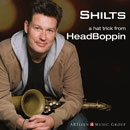 Paul “Shilts” Weimar is usually found blowing alto and tenor sax for UK’s contemporary jazz masters Down to the Bone; he was also a member of the UK’s acid-jazz/neo-soul collective The Brand New Heavies. HeadBoppin’, a collection of nine new originals plus a romp through Stevie Wonder’s little-known “Tuesday Heartbreak,” is Weimar’s debut for a new label formed by, among others, contemporary jazz aces Richard Elliot and Rick Braun, who served as co-producer with Weimer.
Paul “Shilts” Weimar is usually found blowing alto and tenor sax for UK’s contemporary jazz masters Down to the Bone; he was also a member of the UK’s acid-jazz/neo-soul collective The Brand New Heavies. HeadBoppin’, a collection of nine new originals plus a romp through Stevie Wonder’s little-known “Tuesday Heartbreak,” is Weimar’s debut for a new label formed by, among others, contemporary jazz aces Richard Elliot and Rick Braun, who served as co-producer with Weimer. “The main idea behind my solo work is that it’s completely away from everything I do with Down to the Bone,” Weimar explains. “My roots go back to ‘70s funk and soul stuff, but I also love bringing that up to date with all the new technology…so HeadBoppin’ is really a blend of modern sounds and retro flavors.”
Weimar masterminds a bright and colorful mixture of Motown soul and contemporary jazz, over which his saxophones blow hard and friendly. His own writing creates melodies so strong that you can’t tell which track Wonder wrote without searching the credits. “I’ve always liked to play in the high energy style of the band, but it’s all groove and style,” Weimar explains. “With my own material, I write for my sax as if it were a vocal instrument. It’s more melody than riff based, and the goal is to create songs that listeners can’t get out of their heads.”
Mission accomplished. Weimar’s band, especially the rhythm section of Ricky Lawson (drums), Lenny Castro (percussion) and Freddie Washington (bass), either chills or cooks, as the groove dictates. Washington sneaks just a wee li’l bit of the P-Funk bomb “Flashlight” into his intro to “Break the Mold,” a call and response workout between lead saxophone and the band, and drops his own thunderous depth charges from the bridge to summon everyone back to the four/four groove of “I Knew You’d Like This.”
Though his hot, bright playing most often suggests David Sanborn, Weimar sounds much the better for the slower groove of the set’s one ballad, “Good Evans,” which seems to allow him to contemplate the material more deeply--to breathe through instead of blow through his saxophone playing, and to flow through the warm, soft liquid spaces between jazz, funk, soul and pop. The set-ending “Mrs. Magic,” a groove that glides clean and sharp, makes you glad to stuck around through the finish.
By Chris M. Slawecki - allaboutjazz.com
Technorati Tags: Jazz, Smooth Jazz, Music
No comments:
Post a Comment